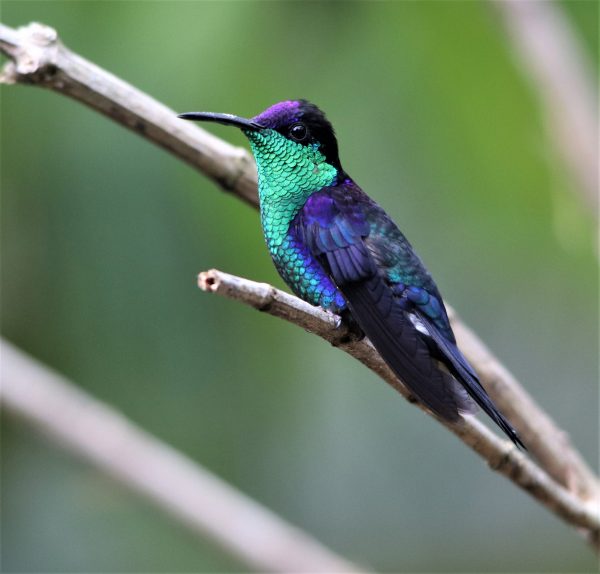
Crowned Woodnymph, Rio Santiago, Honduras
This March I was fortunate to visit the Republic of Honduras as a guest of the government Tourist Board, sampling the amazing birdlife. Whatever you might have heard of the country, it is certainly a diversity hotspot. We saw just under 250 species of birds, effectively in 5 days, and we only visited two areas. The total number of species in the country is about 780.
Honduras is very beautiful with stunning mountains, lakes, rivers, wetlands and golden, sandy beaches and, according to our guides, about 40% of the land has some protection in nature reserves and National Parks. It should be an ecotourism hotspot, as nearby Costa Rica is. The “wild east” of the country, La Mosquitia, is a large patch of partly untouched jungle, where few people go; it is the largest wilderness area in Central America. A significant proportion of the bird species in Honduras are not found in Costa Rica, and vice versa.
When I mentioned to some people that I was going to Honduras, the reaction was fascinating. Some people don’t know where it is – the answer being the northern part of the Central American isthmus, bordered by Guatemala, El Salvador and Nicaragua. Those countries often set off alarm bells, and many people expressed concern about visiting such a “dangerous” area. It is true that Honduras is notorious for its crime, mainly, inevitably, linked to the drugs trade. Swathes of the population have left the country, often trying to reach the USA through Mexico, to the north. Clearly crime and poverty hurts the locals.
As a tourist, however, I would have to say that I loved every minute of visiting this country. After somewhat nervously arriving at the airport at San Pedro Sula, I never felt threatened at all, although I obviously spent my time with local guides. The two lodges we visited were peaceful and calm. On several days we left our possessions in locked cars for a while, looked after by guards, and had no problems.
Furthermore, my guides were adamant that the crime threat to visiting tourists has long been overestimated, and is actually low (most crime is drug-related.) They also say – and other sources also back this up – that things are currently much better than they were only a short time ago. It seems that Honduras can and should become an up and coming destination, especially for birders.
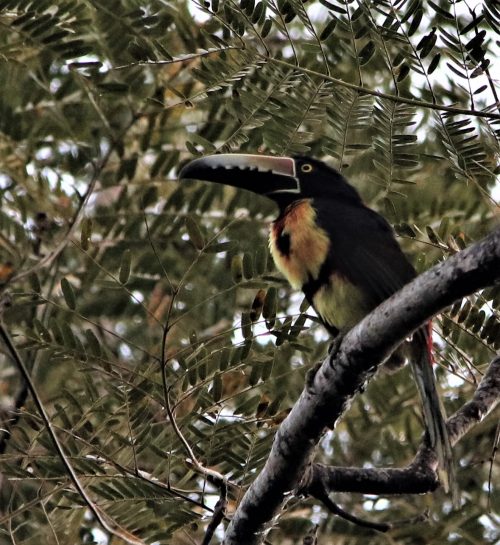
Collared Aracari, Pico Bonito, Honduras
My wonderful guides were Katinka Domen and William Orellana, a couple of exceptional talents who lead Beaks and Peaks Birding and Adventure tours https://www.beaksandpeaks.com/, (not just to Honduras.) I would heartily recommend them for many reasons, some of which I detail in this blog later on. Katinka is from Belgium and William is Honduran. I also had the pleasure of working with the amazing Natalie Mahomar, who works for Honduran tourism from a base in Miami, Florida! With young people such as these promoting the country, surely Honduras has a good future.
My companions for this trip, incidentally, were husband and wife team Ashley Grove and Wendy Palmer-Grove, who run their own tour company called Experience Nature Tours http://www.experiencenature.co.uk/. Judging by my week with them, their tours must be a lot of fun.
4th March 2020
I took the flight London Heathrow to Atlanta, Georgia, had an overnight there and then flew 3.5 hours to San Pedro Sula, Honduras’ second city, the following morning. We all disgorged from the airport into the tropical sunshine and the bliss of anticipation. A 90 minute drive south in Beaks and Peaks’ 4×4 took us to our first destination, the wonderful PANACAM LODGE, Santa Cruz de Yojoa http://www.panacamlodge.com/the-lodge-2/?lang=en
We had lunch on the restaurant balcony as the hummingbirds, mainly Rufous-tailed Hummers and Violet Sabrewings, flitted and buzzed to and fro from the feeders and calls echoed from the forest below. Panacam Lodge is situated with Meambar Blue Mountain National Park at 750m, so is right within great birding habitat. The view from my room’s balcony was gorgeous.
We took a short walk around the lodge to get our Central American birding antennae working. We managed a hat-trick of motmots, each squawking or hooting in their own way; the speciality here is the Keel-billed Motmot, which was the one species that didn’t show, hidden by the canopy of a huge tree as it called. Seeing far-off Keel-billed Toucans flying over the forest canopy ensured that we had encountered the only two birds in the world with the epithet “Keel-billed” – something to tell the grandchildren.
The trees and shrubs harboured good numbers of North American migrants still lingering in their tropical wintering grounds. This would be a feature of our birding in the days to come.
A tree outside our lodgings was used by a colony of Chestnut-headed Oropendolas, those birds that build the remarkable hanging nests that look like socks hanging from a line.
Panacam Lodge, 14.40 until dark
Great Tinamou (heard) – Little Tinamou (heard) – Red-billed Pigeon (heard) – White-tipped Dove – White-collared Swift (lots) – Long-billed Hermit – Violet Sabrewing – White-bellied Emerald – Rufous-tailed Hummingbird – Black Vulture – Turkey Vulture – Grey Hawk – Short-tailed hawk – Zone-tailed Hawk – Ferruginous Pygmy Owl (heard) – Collared Trogon (heard) – Lesson’s Motmot – Keel-billed Motmot (heard) – Turquoise-browed Motmot – Collared Aracari – Keel-billed Toucan – Golden-fronted Woodpecker – Golden-olive Woodpecker – White-fronted Parrot – Olive-throated Parakeet – Black-faced Ant-thrush (heard) – Streak-throated Woodcreeper – Northern Bentbill (heard) – Least Flycatcher – Philadelphia Vireo – Brown Jay – White-breasted Wood-Wren (heard) – Clay-coloured Thrush – Yellow-throated Euphonia – Chestnut-headed Oropendola – Montezuma Oropendola – Giant Cowbird – Melodious Blackbird – Red-crowned Ant-Tanager – Yellow-winged Tanager – Chestnut-sided Warbler
5th March
Lake Yojoa, in the west, is the largest lake in Honduras, which isn’t saying much because it is only 79 square kilometres in surface area. It is formed in a volcanic depression at about 700m elevation. Despite its size, it supports quite a fishing industry, and large numbers of restaurants have built up around its perimeter. However, there is plenty of good habitat left, with freshwater marshes and open water. There are some problems with water pollution, but the area is the richest place for birding in the country. We visited two small parts of the lake shore.
Before dawn today we took the 40-minute drive to Sendero Acuatico El Canal, on the northern shore: according to e-bird, nearly 250 species have been recorded at this single spot. It is indeed a canal about 50-100m wide, with forest on one side, that leads to some marshland on the shore of the lake. We took two small boats and explored, covering no more than a couple of kilometres in two hours.
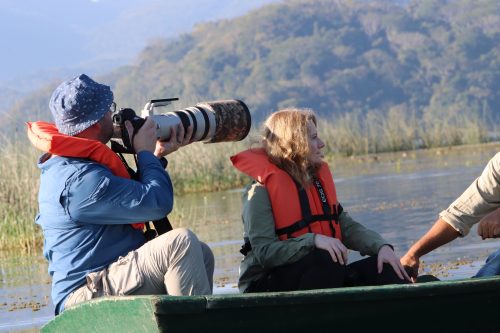
Ashley and Wendy on Lake Yojoa
The canal proved to be a wonderful thoroughfare, with noisy parrots and silent pigeons commuting overhead, and aerial foragers such as Greater Kiskadees, Social and Boat-billed Flycatchers seemingly perched on every snag – these birds will snatch anything from large flying insects to lizards and, occasionally fish, in brief sallies from their perches. The very early hour also meant that we saw some special sights along the banks; alongside numerous herons of many species was a single Limpkin – a bird in its own family that looks like an ibis but calls like a crane – a delightful Northern Waterthrush (a winterer from North America), several species of kingfisher and then two big bonuses, a fabulous view of a scarce Honduran bird, the Russet-naped Wood-Rail and, amazingly, a Neotropical Otter, which slipped down from its sunning spot on a dead log and into the water, surfacing a few times. These animals are slightly larger than Eurasian Otters, with much flatter heads.
Motoring out into the lake itself, we could see more herons, grebes and waterfowl, the latter including a bird familiar to many people, the Muscovy Duck. Here in tropical America, the bird is found truly wild; the name Muscovy Duck alludes to the thought that some birds imported into Europe came from Russia. Snail Kites and Western Ospreys flew over, giving great views, while several species of swallows swept over.
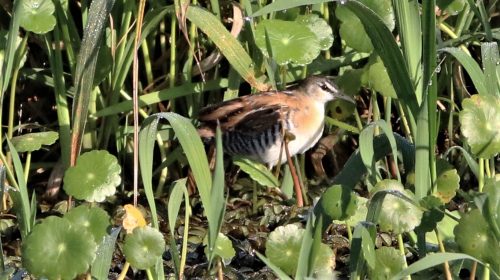
Yellow-breasted Crake, Lake Yojoa
Katinka and Will had a surprise for us. With great care we manoeuvred past a bank of reeds and the boatmen pushed hard against the thick floating vegetation, as tension and anticipation mounted. A couple of calls on the loudspeaker, sparingly done, eventually lured two Yellow-breasted Crakes into view. From their illustration in the book I had expected them to be quite large, but they turned out to be so minute that I almost laughed – almost mice with long legs. Glorious little birds, here in just about the only reliable spot in the country, and one of very few in Central America. Amazingly, while we sat waiting for the crakes, a Pinnated Bittern appeared right out in the open – another Honduran “mega”.
On the way back, in between photographing Tiger-Herons and Green Kingfishers, Will tried to get us excited by the rare, but horrendously skulking (and maybe sulking) Green-backed Sparrow. We heard it well, and saw it just about. Meanwhile, an Altamira Oriole was nest-building overhead.
On journey, as dawn was breaking – Tropical Mockingbird
Lake Yojoa – Sendero Acuatico El Canal, Cortes 07.00-09.30
Black-bellied Whistling-Duck (90) – Fulvous Whistling-Duck (50) – Muscovy Duck (15) – American Wigeon (2) – Blue-winged Teal – Pied-billed Grebe (10) – Pale-vented Pigeon – Red-billed Pigeon – Inca Dove – White-tipped Dove – Groove-billed Ani (6) – White-collared Swift (60) – Rufous-tailed Hummingbird – Pinnated Bittern (1) – Green Heron – Bare-throated Tiger-Heron – Black-crowned Night-Heron – Great Blue Heron – Great Egret – Snowy Egret – Little Blue Heron – Tricolored Heron – Cattle Egret – Limpkin – Russet-naped Wood Rail – Yellow-breasted Crake – Purple Gallinule – Common Gallinule (Moorhen) – American Coot – Black-necked Stilt – Northern Jacana – Spotted Sandpiper – Neotropical Cormorant – Turkey Vulture – Black Vulture – Western Osprey – Snail Kite – Gartered Trogon – Ringed Kingfisher – Belted Kingfisher – Green Kingfisher – Golden-fronted Woodpecker – White-fronted Parrot – Red-lored Parrot – Olive-throated Parakeet – Ivory-billed Woodcreeper (heard) – Streak-throated Woodcreeper – Black Phoebe – Great Kiskadee – Boat-billed Flycatcher – Social Flycatcher – Tropical Kingbird – Brown Jay – Barn Swallow – Northern Rough-winged Swallow – Tree Swallow – Spot-breasted Wren – Rufous-naped Wren – Wood Thrush (heard) – Yellow-throated Euphonia – Northern Waterthrush – Common Yellowthroat – Chestnut-sided Warbler – Black-headed Saltator – Green-backed Sparrow – Red-winged Blackbird – Melodious Blackbird – Great-tailed Grackle – Bronzed Cowbird – Altamira Oriole – Baltimore Oriole – Montezuma Oropendola
Having seen 80 species by 10am, we retired to D&D Adventures (and Brewery) https://ddbrewery.com for a long brunch. This is, apparently, THE place to go if you are an independent traveller to Honduras, as it is a meeting place and organises many adventurous activities. It was also the place where William and Katinka met a few years ago. There were small groups of young backpackers hanging around, as well as hummingbirds and a Wilson’s Warbler, and the food was excellent.
Not far down the road is a lakeside hotel, El Cortijo del Lago http://cortijo.yojoa.org/default.html. The garden here absolutely heaves with birds. We were soon watching a large, mixed flock of birds, among them a couple of good North American winterers, Yellow-throated Vireo and Summer Tanager, while Magnolia and Black-and-white Warblers are always great value – here in Honduras the latter tended not to forage on tree-trunks, their default setting on their breeding grounds. Among other good birds here were Cinnamon Hummingbird, the only one we saw on the trip, the complete midget known as a Northern Beardless Tyrannulet, the stunning Green Honeycreeper (a definite tropical bird) and a quick view of Spot-breasted Oriole. Meanwhile, Natalie was especially excited to see the Lesser Yellow-headed Vultures flying over, showing obvious contrast between inner and outer wings. These birds are related to Turkey Vultures, and along with them are among the few scavenging birds known to use smell to detect food items. The Lesser Yellow-headed Vulture is a wetland bird and seems to feed mostly on carcasses of fish and reptiles.
Lake Yojoa – El Cortijo del Lago, Cortes
Blue-winged Teal – Ruddy Ground-Dove – Vaux’s Swift – Green-breasted Mango – Rufous-tailed Hummingbird – Cinnamon Hummingbird – Great Egret – Little Blue Heron – Cattle Egret – Northern Jacana – Lesser Yellow-headed Vulture – Western Osprey – White-tailed Kite – Snail Kite – Zone-tailed Hawk – Roadside Hawk – Ferruginous Pygmy-Owl (heard) – Lesson’s Motmot – Golden-fronted Woodpecker – Golden-olive Woodpecker – Crested Caracara – Olive-throated Parakeet – Northern Beardless Tyrannulet – Yellow-olive Flycatcher – Tropical Pewee – Least Flycatcher – Dusky-capped Flycatcher – Great Kiskadee – Tropical Kingbird – Yellow-throated Vireo – Brown Jay – Northern Rough-winged Swallow – Clay-coloured Thrush – Yellow-throated Euphonia – Blue-winged Warbler – American Redstart – Black-and-white Warbler – Magnolia Warbler – Chestnut-sided Warbler – Tropical Parula – Blue-grey Tanager – Yellow-winged Tanager – Green Honeycreeper – Morelet’s Seedeater – Variable Seedeater – Greyish Saltator (heard) – Summer Tanager – Great-tailed Grackle – Spot-breasted Oriole
Our next port of call was an unusual one. Part of the conditions for the government sponsoring my trip to Honduras was for me to present a workshop on bird tourism for local interested parties. Thanks to some superb help from Andy Tucker at Naturetrek, and my colleague Stephen Moss, I was able to gather some useful figures and examples. Together with Natalie, who translated, we spoke for nearly an hour to 10-15 people, who were much engaged. All of them want to promote birding tourism to this country. I don’t know what the rest of them felt, but I finished the session pretty uplifted.
Meanwhile, there were a few species around the conference centre:
Rufous-tailed Hummingbird – Stripe-throated Hermit – Turkey Vulture – Grey Hawk – Great Kiskadee – Grey-breasted Martin – Morelet’s Seedeater
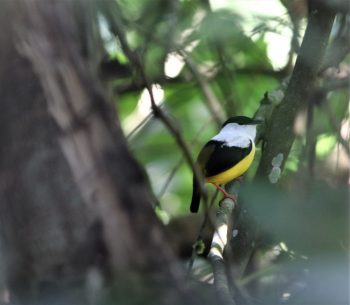
White-collared Manakin, Panacam Lodge, Honduras
And so, back to Panacam Lodge, with the birding brains of Ashley, Wendy and I already on overload. Nevertheless, a short stop on the track to the Lodge revealed a couple of delights: firstly, a soaring Swallow-tailed Kite, a bird I have wanted to see for years. Secondly, we had some good views of the lovely White-collared Manakin. This, in common with the rest of its family, is no ordinary creature. Eating abundant fruit and insects, it is a bird that has plenty of time to spend in elaborate displays. Males gather together in leks, each bird “owning” a personal arena with several vertical perch, next to which it clears excess vegetation. On the arrival of a visiting female, the male performs a “dance” consisting of jumping from perch to perch, “about-facing” as it lands. At the same time it makes extraordinary sounds simply by flapping its wings at super-high speed. The birds here were making exactly the same sound as those fire-crackers that you buy at parties, along with longer, dry, flatulent sounds. One male showed itself well through the forest undergrowth.
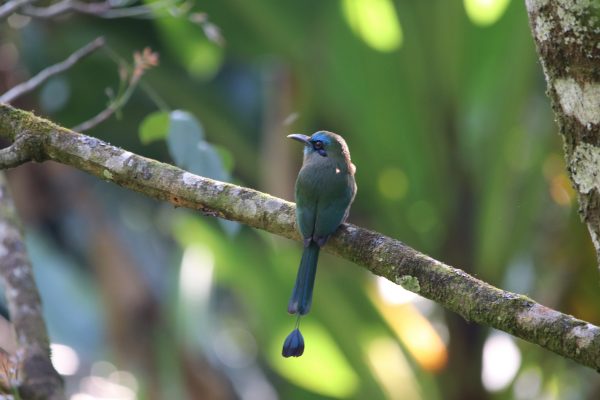
Keel-billed Motmot, Panacam Lodge, Honduras
Meanwhile, at Panacam Lodge itself, yesterday’s invisible Keel-billed Motmot took pity on us and perched out in the open, low down, for about half an hour. Above the Lodge, in some trees with pink-flowers, a flock of the highly localised and pretty rare Barred Parakeet was foraging. We also saw a White-nosed Coati, a mammal related to the Racoons.
The day’s official bird list ended at 129 species.
PANACAM Lodge
White-collared Swift – Swallow-tailed Kite – Short-tailed Hawk – Keel-billed Motmot – Turquoise-browed Motmot – Collared Aracari (heard) – Keel-billed Toucan (heard) – Barred Parakeet – White-collared Manakin – Masked Tityra – Clay-coloured Thrush – Yellow Warbler – Great-tailed Grackle – Chestnut-headed Oropendola – Montezuma Oropendola
6th March
This is a narrative version of the day. Scroll down to the list of birds seen.
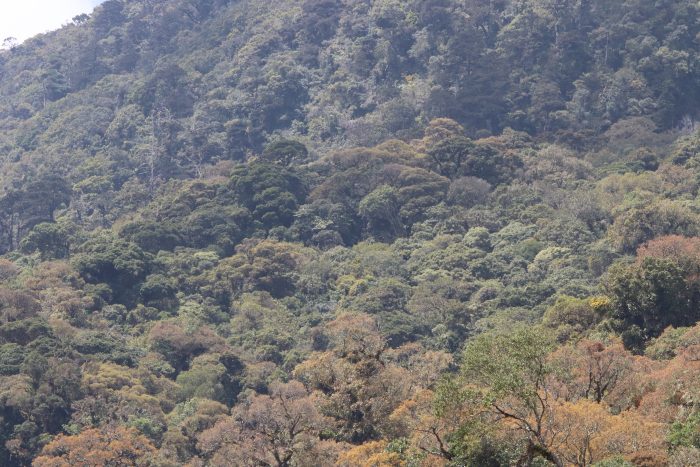
The plateau at El Cedral, surrounded by Quetzal-rich cloud-forest
One of Central America’s biggest bird prizes – indeed, one of the world’s most sought-after birds – is the peerless Resplendent Quetzal. In our book 100 Birds to See in Your Lifetime, David Chandler and I rank it as the world’s twelfth most exciting bird – out of the 11,000 or so species on earth. There are several reasons why this bird is such an icon. Firstly, it is stunningly beautiful to look at, especially the male with its iridescent plumage and extraordinary long tail-plumes. Secondly, it has a restricted range in higher-altitude (cloud) forest in Mexico, Guatemala, Honduras, Costa Rica and tiny parts of Nicaragua, El Salvador and west Panama. Thirdly, it has long been a cultural phenomenon, right from Mayan times (2000 BC to 1697 AD;) the currency of Guatemala is called the quetzal. It all adds up to a compelling package.
Seeing a wild Resplendent Quetzal is difficult. The forest habitat can be hard to reach, the birds are shy and the tall trees that they inhabit, often bedecked with mosses and higher epiphytic plants, can make it difficult to spot them. A few are staked out in Costa Rica, but not here in Honduras. We knew, therefore, that we were in for something of a quest today. What I didn’t expect was to see a truly remarkable example of human perseverance, guides going the second mile and then beyond, and coming across one of the loveliest places I have ever seen in my life.
We assembled outside our rooms for the pre-dawn ride into Santa Barbara National Park, and it soon became apparent that Ashley was not well. He had been up for half the night with sickness and stomach cramps. I fully suspect that, had he not been looking for the Quetzal, (which the Groves had never seen), he would have stayed sensibly in bed. That’s what Quetzals do to people. We took a short drive as far as the house of Lionel, a remarkable Honduran who had decided to keep some of the cloud-forest on his land intact, to preserve the birds – the El Cedral project is partly sponsored by Beaks and Peaks. At the smallholding we were served the most nutritious breakfast of beans, eggs, avocados and lashings of coffee, while Ashley looked on, his face pallid, his demeanour haunted. He knew that he faced what Katinka and Will, our guides in their thirties and experienced in adventure travel, were calling “an appreciable hike”.
Personally speaking, if there is one thing I love doing as much as birding it’s hill-walking. Wendy, too, was in her element. It was clear after about ten minutes, though, that Ashley was struggling; I fully expected him to give up any moment. In the meantime, we were walking across a clear area with views across the forested mountains of Montana Santa Barbara National Park; the wind swept threatening clouds across the peaks. As we ascended, Will and Katinka pointed out some good species, such as the localised Rusty Sparrow and the very smart White-naped Brush-Finch, as well as Yellow-backed Oriole flying over. We tried a stake-out for the Lesser Roadrunner, but our luck was out. Eventually, we turned a corner and began to ascend more sharply, reaching the edge of Lionel’s forest.
Now, further high-quality birds began appearing. Spotted Woodcreeper and Ruddy Foliage-gleaner called and we glimpsed a Slate-throated Redstart. A Green-throated Mountain-gem (a hummingbird) sped past, which I failed to see. Shortly afterwards, the distinctive descending notes of a Black-faced Antthrush came from very close by. Antthrushes are much beloved by birdwatchers in tropical America because they are full of character. They walk along the forest floor, tail cocked up and wide-eyed, moving with that slightly detached air of a window-shopping chicken, if you can imagine that. Restricted to shady leaf-litter, they are tricky to see. But here, at what must have been their altitudinal limit (they just reach 1500m), two or three showed rather well. Indeed, after he had trudged up the path towards us, sweating profusely and apparently striding through treacle, even Ashley managed to see one.
After another quarter of an hour, we reached, rather unexpectedly, a bench in a clearing, here in an Honduran cloudforest looking as though it belonged in a park in Milton Keynes with a litter-bin and swings next to it. “The Quetzals sometimes come down this far,” said William, as another Green-throated Mountain-gem zoomed past like a leaf in the wind – or at least, I assumed that this was what it looked like, having missed it again. We gazed up at the trees, the canopy seemingly several storeys above our heads, every snag and branch and profusion of hanging vegetation a potential perch for our quarry. But the forest had gone quiet. The wind across the valley moaned.
Lionel pointed upwards. Today, the Quetzals were at higher altitude. The path got steeper, and occasionally a bridge crossed one of the gullies. As we walked, we gradually became aware of an almost ethereal voice coming from the middle levels of the forest, sweet and deliberate with a slightly quavering, mystical, tinny air – if anyone is a Hunger Games fan, the effect is quite like Rue’s Whistle in Mockingjay. “Ah, the sound of the cloudforest,” said Will, wistfully, “the Slate-coloured Solitaire.” We listened, spellbound, and amazingly the voice was joined by another fine songster, albeit a more hurried one, an Orange-billed Nightingale-Thrush. Together with the insistent “iisshh!” of a Yellowish Flycatcher, the soundscape was thrillingly novel. What a setting this would be, I thought, to see a Quetzal.
Other excitements came and went as we continued upwards – groups of Bushy-crested Jays, black and ultramarine with yellow staring eyes, a couple of Northern Emerald Toucanets and even a distant bulk of a Crested Guan, scarce here. I missed the Green-throated Mountain-gem twice more, despite hearing the buzz of its wingbeats past my face on one occasion. It was taunting me. And so, let’s be honest, were the Quetzals.
Enveloped in this extravagant world I had forgotten about Ashley. I assumed he was puffing up the hill somewhere like an overworked steam-train, but Katinka caught up and brought the expected news that he had finally slumped down on a tree stump far below, now suffering heart palpitations. After an anxious wait, Wendy reported that he was fine but down and out. We would need to give the Quetzals a go without him.
It was at least another half hour of climbing before we came to a place where Lionel stopped and asked for hush. “This is their main feeding area,” whispered Will. For a long time we waited. Then Lionel and Will looked at each other. “There’s one calling, but far.” Needless to say, the call of the opulently plumaged Resplendent Quetzal is a tad disappointing, a downslurred, almost apologetic “gowk.” I could barely make it out. But at least the birds were about. We waited, clinging on to reasonable hope.
Of course, once a Quetzal did appear, the long periods of waiting led to pandemonium. The unmistakable silhouette, tail train trailing, swooped over and landed half way up a forest giant. It was, of course, on a particularly rough and steep slope. There was frantic waving, pursing of lips, slipping over, grabbing and cursing. Eventually the bird, in its ridiculous loveliness, adorned a scope view, briefly before vanishing. A rule of life, though, is that one Quetzal is never enough, so we spent the next half-hour trying to see another. There were fleeting glimpses, volleys of Spanish, much squinting and times of silence broken only by thuds from exerting hearts.
The next apparition was even more unexpected. Out behind the green curtain of lavish vegetation came…Ashley. He had somehow found the strength and resolve – and the knowledge that the Quetzal was no longer mythical – to haul his suffering body and mind higher up the cloud-forest. He joined Katinka, Lionel and Will in an effort at least to cast eyes on one.
Wendy and I had by now edged a little higher, round a couple of bends. “Your husband has no end of determination,” I found myself murmuring. And then, with a gasp. “Stop. Don’t move. Take the tree with sun on it and move right a metre.” A male Quetzal, with a train as long as a Canadian goods convoy, had landed in full view twenty metres away. It was so close I took a recognisable mobile phone shot without any magnification – my proper camera was out of reach, of course. Its shimmering gorgeousness, with lustrous iridescent green all over bar a brilliant crimson breast, made it look as though the whole showy luxuriance of the forest had been distilled into a single bird. No wonder the Maya were captivated.
“O…M…G,” gasped Wendy, wide-eyed with incredulity. We high-fived.
Somewhat later, ashen-faced Ashley plodded up to our perch on cloud nine. “I saw the back end of a female,” he declared, and it seemed churlish to over-share.
A cloud seemed to have crossed Will’s face. “He didn’t manage to get a picture,” he said. “Ashley needs a photo.”
It is remarkable that a Quetzal hike should have a second objective, but Katinka and Will had assured us that, a few hundred metres further on, the forest would give way to clearer vegetation and there, if we were lucky, we should find a Wine-throated Hummingbird. This excited me greatly. I had seen a Quetzal before (in less splendid circumstances – during a Bird Race, of all things!) but I had harboured ambitions of seeing this rare and little-known jewel even since researching about it prior to a failed attempt to get to Guatemala. It is one of the world’s smallest hummers, and thus one of the world’s smallest birds; it is adorned with an iridescent pink gorget; and it resides at altitude only in a small part of Central America – Mexico, Guatemala, El Salvador and Honduras.
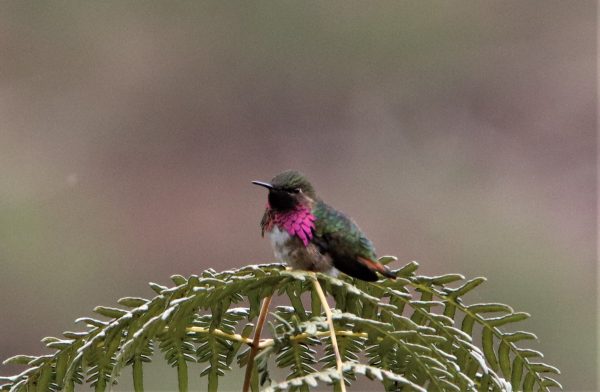
Wine-throated Hummingbird, El Cedral, 06/03/2020
Maybe I was punch-drunk with Quetzal sightings, but when the forest opened out into a small plateau that had been converted into a small farm, I just gasped at the beauty of the place. Not only was it on a mountain slope surrounded on all sides by the forest, but almost everywhere there were flowers. Admittedly, in an ecological sense they were all invasives – I could see Common Field Speedwell, for example – but in this rarefied place, bursting with vigour and colour, they made the upland garden bloom. A young man walked past and, despite the fact that he must have spent some hours harvesting, gave each of us a handful of raspberries (or similar) – such generosity. We also took some guavas off the bush (we were with the owner Lionel, of course). Hiking, birding, foraging, mountains – a day of nourishment.
The appointed place was a large patch of shrubs that bore large, pink blossoms. We ran into our midget immediately. Over the last day or two we had become accustomed to seeing hummers, and so it was easy to appreciate just how small the Wine-throated Hummingbird is – just 6.5-7cm, while the world’s smallest bird, the Bee Hummingbird, is 5-6cm in length; by contrast the White-necked Jacobin, common here, is 11cm and the Rufous-tailed Hummingbird 9cm. We watched a male seemingly on territory, occasionally displaying and fluffing its remarkable pink badge. Although not well known, this hummer should be on everybody’s wish-list of birds to see.
It was a wrench to leave this Elysian meadow, but having enjoyed perfect views of the Wine-throated Hummingbird, it was time to go down the mountain at last. But in fact, our guides had other ideas. Back inside the forest, they declared: “We are going to try for the Quetzal again.” You should bear in mind that, with Ashley unwell, Katinka and Will (and Lionel, who was carrying Ashley’s very heavy camera gear) had probably climbed the mountain one and a half times already. Wendy and I had gorged on the bird, and Ashley had at least seen one. But, knowing how much it meant, they were determined to get Ashley his Quetzal shot, no matter what. I can assure you, there are any number of guides who would have given up by now.
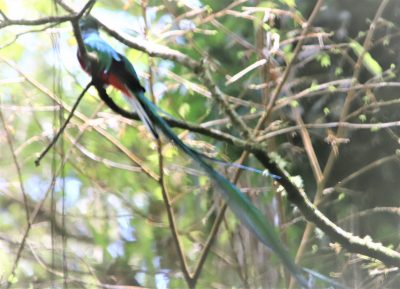
Resplendent Quetzal, El Cedral
In such circumstances, it was no wonder that a Quetzal at last relented. After a wait, a male came and perched apologetically within range of Ashley’s camera – and mine, sort of (see photo). As it sat, it long tail swayed in the wind.
There were a couple of other treats on the way down. We had a good, close of another rare hummingbird, an Emerald-chinned Hummingbird, another Central American endemic and at last, on roughly the 738th attempt, I finally managed to see the Green-throated Mountain-gem, happily adding to the other three species of Mountain-gems I have seen in Costa Rica.
We descended the mountain and retired to nearby Ivo’s Restaurant, to enjoy one of the sweetest celebratory meals I have ever enjoyed – they even served a latte. Birds were all around the garden.
As Ashley took a piece of bread and munched his first food of the day, I asked him, in the light of his epic and heroic climb: “What do you think of Honduras, then, Ashley?”
Without a moment’s hesitation, he replied: “Hilly!”
PANACAM – Mottled Owl (heard)
El Cedral, Santa Barbara National Park
Crested Guan – White-tipped Dove (heard) – White-collared Swift – Green-throated Mountain-gem – Emerald-chinned Hummingbird – Wine-throated Hummingbird – Rufous-tailed Hummingbird – Black Vulture – Turkey Vulture – Swallow-tailed Kite – Zone-tailed Hawk – Ferruginous Pygmy-Owl (heard) – Resplendent Quetzal (7) – Collared Trogon – Northern Emerald Toucanet – Golden-olive Woodpecker – Black-faced Ant-thrush (3) – Spotted Woodcreeper – Ruddy Foliage-gleaner – Yellowish Flycatcher – Dusky-capped Flycatcher (heard) – Great Kiskadee – Boat-billed Flycatcher – Tropical Kingbird – Bushy-crested Jay – Orange-billed Nightingale-Thrush (heard) – Black-headed Nightingale-Thrush (heard) – Black Thrush – Clay-coloured Thrush – Slate-coloured Solitaire – Yellow-throated Euphonia – Black-and-white Warbler – Wilson’s Warbler – Slate-throated Redstart – Yellow-winged Tanager – Yellow-faced Grassquit – Common Chlorospingus – White-naped Brush-Finch – Rusty Sparrow – Rufous-collared Sparrow – Great-tailed Grackle – Yellow-backed Oriole
Ivo’s restaurant, Los Naranjas
White-winged Dove – Rufous-tailed Hummingbird – Black Vulture – Turkey Vulture – Golden-olive Woodpecker – Social Flycatcher – Rufous-naped Wren (3) – Crimson-collared Tanager – Black-headed Saltator
7th March
Honduras had endured a late season, and yesterday’s clouds on the Santa Barbara mountains turned to rain around the lakeside. After a short drive to the Eco-Finca (agricultural smallholding run on environmental lines) of Luna del Puente, https://luna-del-puente.principalwebsite.com/ we enjoyed our dawn coffee under the shelter of a large tree. This is one of the top hotpots of Honduras, with an incredible 286 species recorded according to e-bird, just in an area no larger than a city park. Despite the weather, we still saw about 70 species in a couple of hours.
This is a gorgeous place, with an excellent mix of different forest, groves of coffee and cocoa production, a river, marshy ground and scrub. Just around the gardens (which have camping, playgrounds and educational facilities) there were flocks of gaudily coloured birds such as Golden-hooded Tanagers (one of my favourites,) Red-legged Honeycreeper and Rufous-browed Peppershrike. In the open area we managed to find the very smart White-faced Ground-Sparrow, a real skulker, and the splendidly patterned Barred Antshrike, while a Grey-headed Kite flew over. In the forest we caught up with our first Black-headed Trogon of the trip, but sadly couldn’t find one of the specialities here, the curious Tody Motmot. Katinka pointed out two intriguing members of the great family of American Flycatchers, the Tyrannidae: the Eye-ringed Flatbill and the Northern Bentbill. Both spend much time motionless on perches in the forest, scanning for food and both, very specifically, sally to leaves and grab prey from their undersides. The Eye-ringed Flatbill, whose bill is laterally extended, hunts at any level, often in the canopy, and often follows mixed-species flocks. The Northern Bentbill, on the other hand, whose bill twists downwards very obviously, mainly huts low down. It has a frog-like call which we heard several times. These two, both of which are Central American specials, are good examples of very specialised foraging, the sort that is possible in tropical forests.
After our birding, with the rain now pouring down, we retreated to the restaurant. Here they served what must have been the most perfect cup of cocoa I have ever tasted, here in the very spot where it was grown.
Luna del Puente Private reserve, Santa Cruz de Yojoa, Cortes
Plain Chachalaca – Buffy-crowned Wood-Partridge (heard) – Pale-vented Pigeon – Red-billed Pigeon – Ruddy Ground-Dove – White-tipped Dove – Grey-headed Dove (heard) – Stripe-throated Hermit – Rufous-tailed Hummingbird – Great Egret – Grey-headed Kite – Black Vulture – Turkey Vulture – Ferruginous Pygmy-Owl (heard) – Black-headed Trogon – Gartered Trogon – Lesson’s Motmot – Turquoise-browed Motmot – Keel-billed Toucan – Acorn Woodpecker (heard) – Golden-fronted Woodpecker – Olivaceous Piculet (heard) – Laughing Falcon – White-fronted Parrot – Red-lored Parrot – Olive-throated Parakeet – Barred Antshrike – Streak-headed Woodcreeper – Yellow-bellied Elaenia (heard) – Northern Bentbill – Eye-ringed Flatbill – Yellow-olive Flycatcher – Least Flycatcher – Bright-rumped Attila – Dusky-capped Flycatcher – Brown-crested Flycatcher – Great Kiskadee – Boat-billed Flycatcher – Social Flycatcher – Tropical Kingbird – White-collared Manakin – Masked Tityra – Rose-throated Becard – Rufous-browed Peppershrike – Yellow-throated Vireo – Brown Jay – Green Jay (heard) – Wood Thrush (heard) – Clay-coloured Thrush – Grey Catbird – Yellow-throated Euphonia – Tennessee Warbler – Grey-crowned Yellowthroat – Hooded Warbler – American Redstart – Black-and-white Warbler – Magnolia Warbler – Wilson’s Warbler – Chestnut-sided Warbler – Black-throated Green Warbler – Crimson-collared Tanager – Scarlet-rumped Tanager – Golden-hooded Tanager – Blue-gray Tanager – Yellow-winged Tanager – Red-legged Honeycreeper – Blue-black Grassquit – Yellow-faced Grassquit – Morelet’s Seedeater – Greyish Saltator – Black-headed Saltator – Buff-throated Saltator – White-faced Ground-Sparrow – Summer Tanager – Rose-breasted Grosbeak – Blue Grosbeak – Melodious Blackbird – Great-tailed Grackle – Yellow-backed Oriole – Baltimore Oriole – Montezuma oropendola
Our time in central-west Honduras was now over, and we embarked on a lengthy drive towards La Ceiba on the north (Caribbean) coast. Much to the surprise of the English contingent, we stopped for lunch in the middle of the town of El Progreso at a busy Honduran fast-food joint. Mine was spare ribs, fries and coke. We had no issues of security.
We rolled up at Pico Bonito Lodge, in the hills above the coast, during the last of the light, enough to note many hummingbirds flitting about the feeders.
8th March
The Lodge and Spa at Pico Bonito [website currently unavailable] is the best-known ecolodge in Honduras, and surely the most luxurious. It was almost empty when we were there. The service and food were exceptional. Each room is a little building separate from the rest – a little like a Honduran Centerparcs. We had two nights here and, as in the case of Panacam, would have loved to have explored more. A couple of years ago a rumour went round that the Lodge had burned down and was no longer running; apparently it was mischief-making fake news perpetrated by an employee who had been sacked!
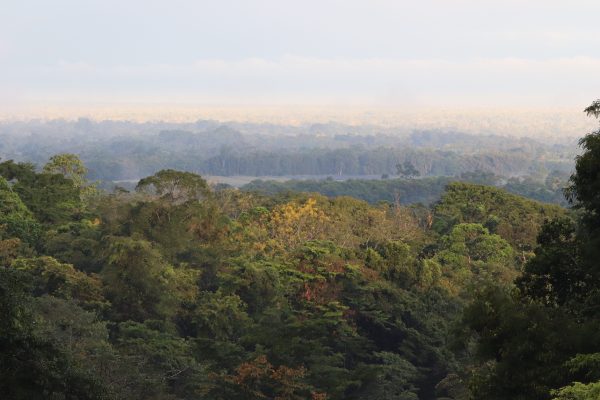
View from the tower at Pico Bonito, Honduras
This morning we spent our time birding the grounds, two sessions broken by a long breakfast (yes, heaven.) The early morning was largely given over to looking for one of the Lodge’s biggest avian draws, the Lovely Cotinga, which involved scanning the treetops from the main tower – not easy considering how many treetops there were, and the fact that it was misty. Somehow our guides managed to spot one, first as a distant blue blob and then, having flown somewhat closer, a bigger blue blob. Little is known about this gaudily-plumaged bird The view up here was pretty special – you can just make out the Caribbean coast. There were many other goodies, especially some spectacular woodpeckers and great views of both Collared Aracari and Keel-billed Toucan.
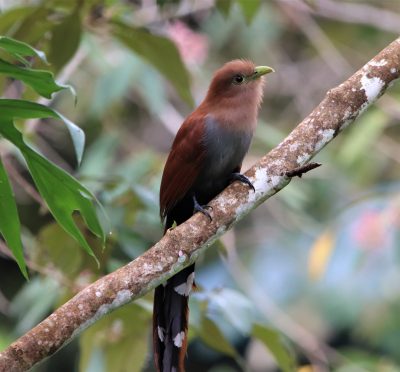
Squirrel Cuckoo, Pico Bonito, Honduras
Quite honestly, the gardens here are a pretty special birding spot in their own right. Breakfast was constantly interrupted by photographic opportunities. We had great views of Squirrel Cuckoo, Olive-backed Euphonia and, of course, the hummingbirds, some of which took the opportunity to bathe in the rain. The top spot, though, was a woodcreeper (the tropical American equivalent of a treecreeper) which was entering a hole in a mighty tree in the garden. It turned out to be a Tawny-winged Woodcreeper, an uncommon species.
Our second birding session took us down the entrance road. Here the mournful call of the Slaty-breasted Tinamou was so clear that it felt inevitable we would see one – of course, we didn’t (it’s a tinamou, dummy.) There was a great range of species here, highlights being great views of Wedge-billed Woodcreeper (it’s got a wedge-shaped bill, no kidding), a gathering of the very common Clay-coloured Thrush, presumably at a berry source, a couple of Tawny-crowned Greenlets and a roosting Great Potoo. Potoos are a little like Nightjars, only with even larger heads and gapes. Like other Potoos, Great Potoos are perch-hunters, sallying out from a lookout point to catch large flying insects. Great Potoos sometimes catch bats in flight.
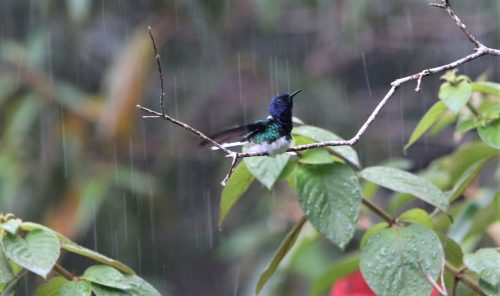
White-necked Jacobin bathing in the rain, Pico Bonito
I managed a short run before lunch, to try to add to my admittedly absurd “world-list-of-things-seen-while-running.” Lesson’s Motmot was the best bird, and I also saw a Central American Agouti and a Black Phoebe on the river. Also had a quick swim – maybe I should begin a “birds-I’ve-seen-from-a-pool” list?
On the way to lunch bumped into the man whose job it is to catch and translocate venomous snakes from the property. He had caught two beauties, a Jumping Viper and a Hog-nosed Viper.
Pico Bonito Lodge area
Little Tinamou (heard) – Slaty-breasted Tinamou (heard) – Crested Guan – Red-billed Pigeon – Ruddy Ground-Dove – Inca Dove – Squirrel Cuckoo – Great Potoo – Green-breasted Mango – Long-billed Hermit – Violet Sabrewing – Crowned Woodnymph – White-bellied Emerald – Rufous-tailed Hummingbird – Black Vulture – Turkey Vulture – Grey Hawk – Ferruginous Pygmy-Owl (heard) – Lesson’s Motmot – Turquoise-browed Motmot – Collared Aracari – Keel-billed Toucan – Chestnut-coloured Woodpecker – Lineated Woodpecker – Black-cheeked Woodpecker – Golden-fronted Woodpecker – Brown-hooded Parrot – White-crowned Parrot – White-fronted Parrot – Olive-throated Parakeet – Wedge-billed Woodcreeper – Tawny-winged Woodcreeper – Cocoa Woodcreeper (heard) – Streak-headed Woodcreeper – Yellow-olive Flycatcher – Least Flycatcher – Black Phoebe – Dusky-capped Flycatcher – Great Kiskadee – Boat-billed Flycatcher – Social Flycatcher – Tropical Kingbird – Lovely Cotinga – White-collared Manakin – Red-capped Manakin (heard) – Black-crowned Tityra – Masked Tityra – Philadephia Vireo – Tawny-crowned Greenlet – Lesser Greenlet – Brown Jay – Stripe-breasted Wren (heard) – Long-billed Gnatwren (heard) – Wood Thrush – Clay-coloured Thrush – Slate-coloured Solitaire (heard) – Olive-backed Euphonia – Scrub Euphonia – Yellow-throated Euphonia – White-vented Euphonia – Ovenbird – Hooded Warbler – American Redstart – Black-and-white Warbler – Magnolia Warbler – Chestnut-sided Warbler – Black-throated Green Warbler – Blue-grey Tanager – Red-legged Honeycreeper – Buff-throated Saltator – Red-throated Ant-Tanager (2) – Melodious Blackbird – Great-tailed Grackle – Baltimore Oriole – Chestnut-headed Oropendola – Montezuma Oropendola
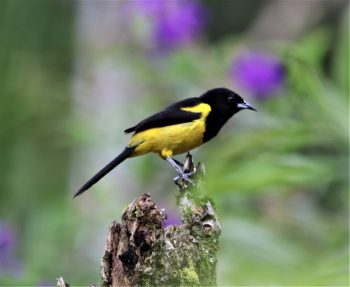
Black-cowled Oriole, Rio Santiiago, Honduras
Our afternoon trip was to the Rio Santiago Nature Resort http://riosantiagonatureresort.com, on the edge of Pico Bonito National Park. A new destination, its future is in doubt and the area is up for sale. A simply incredible 326 species have been seen in the area, nearly half the birds of the whole country. And we managed to find a new one! As we watched from an outbuilding sheltering from the constant rain, we spotted a Nightjar perched above us, its roosting-time thoroughly disturbed by the downpour. After consulting with Honduras guru John van Dort, it turned out to be the rare Short-tailed Nighthawk; perhaps today a Short-tempered Nighthawk, too. Among the good birds seen here is the Sunbittern, although we didn’t even get to look for it in the conditions.
Rio Santiago is particularly well known for its hummingbirds, with 22 species recorded in the gardens, although now isn’t the best season. There were plenty of birds zipping about, including the Scaly-breasted Hummingbird, the first of our trip, but only six species. Another good bird here was Black-cowled Oriole, and there was an incredibly distant King Vulture on the other side of the valley. We made an early return for the Lodge.
Rio Santiago Nature Resort
Red-billed Pigeon – Grey-chested Dove (heard) – White-winged Dove – Groove-billed Ani – Short-tailed Nighthawk – White-collared Swift – Long-billed Hermit – Violet Sabrewing – Scaly-breasted Hummingbird – Crowned Woodnymph – White-bellied Emerald – White-necked Jacobin – Great Egret – Cattle Egret – King Vulture – Black Vulture – Turkey Vulture – Black-headed Trogon – Pale-billed Woodpecker – Laughing Falcon – Olive-throated Parakeet – Black-cowled Oriole
9th March
A quick breakfast on the verandah again showed what a good spot the Pico Bonito garden is. We managed a superb view of the very attractive male Red-capped Manakin, as well as several Euphonias.
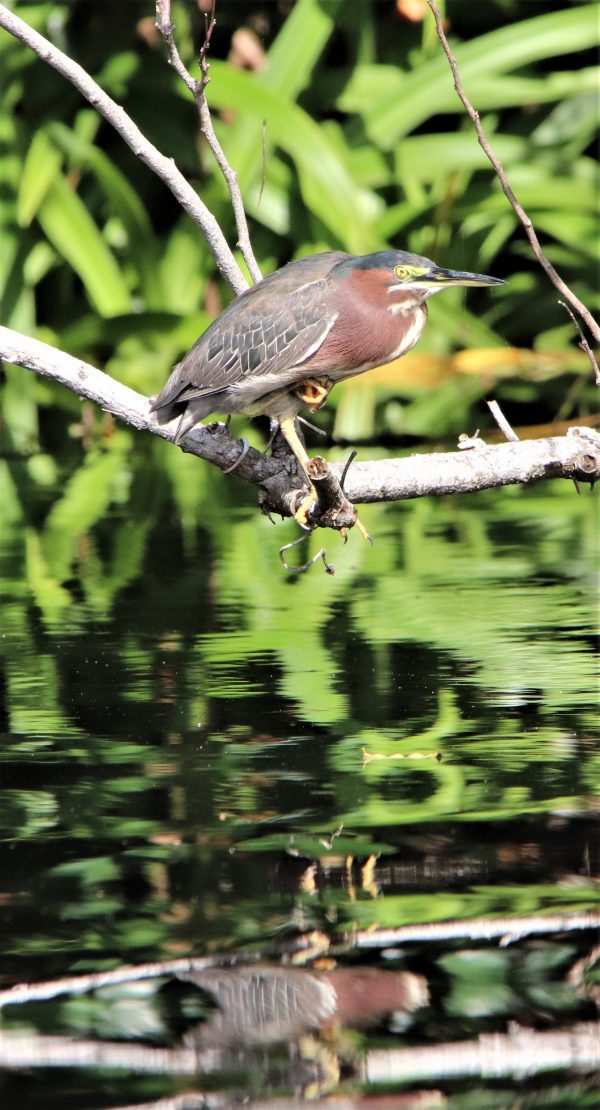
Green Heron, Cuero y Salado Wildlife Refuge, Honduras
Today’s excursion was to the hotspot of Cuero y Salado Wildlife Refuge, half an hour’s drive to the west. This refuge is named after the two rivers, the Cuero and the Salado, that meet there and disgorge into the Caribbean. It is a glorious 35,000 acre tapestry of forest, ranchland, river and mangrove, offering also a scenic view of the coastal hills just inland. Getting there is a delightfully eccentric experience. First you take one of Honduras’ very few remaining railways along a narrow-gauge track for 9km, starting at the village of La Union. This railway has several purposes: taking tourists to the National Park, taking children to school and taking coconuts to a processing plant. It is charming and relaxing, and the guard actually stops every so often to point out the birds along the way in the marshes and fields. Originally built a hundred years ago to transport bananas, the train has been touched up with some new yellow paint, given to celebrate a recent presidential visit, as well as one by Honduras-friendly Michael Douglas and Catherine Zeta-Jones. The train creaks a little, but is simply great fun, especially because the locals still use it. On our way out we saw Jabiru, rare here, as well as White Ibis and Wood Stork.
The next part of the experience is taking a boat out on to the broad, tranquil waterways on a small motorised skiff, which enables you to get into small bays and quiet corners – mind you, since ours was the only boat we saw all morning, every corner was quiet. The area is quite good for American Manatee, although we didn’t see one; our boatman had done so the day before. Apparently they are easiest to see right by the sea where the coast meets the river. All you see is a nose, but it would still have been exciting.
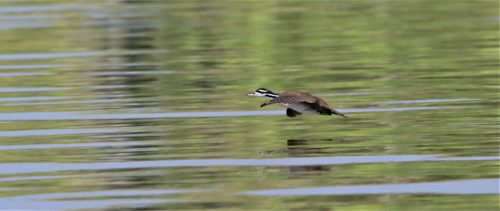
Sungrebe, Cuero y Salado Wildlife Refuge, Honduras
The birds, though, were fantastic. A huge range of herons and egrets included the nocturnal Boat-billed Heron, while we also got excellent views of the highly sought-after Neotropical oddity, the Sungrebe. It isn’t a grebe, but is placed in a family with two other species, the Finfoots, vaguely related to rails. It is famous for having an extraordinarily short incubation period, only 10-11 days (like a Skylark, but quicker than a Blackbird). The 2-4 young hatch virtually naked and helpless, and are carried in a fold of skin under the male’s wing, even when he flies. Strange.
Aside from this, we had some great views of other birds, such as Common Black Hawks, Lesser Yellow-headed Vultures, roosting Common Nighthawks, the scarce Mangrove Cuckoo, White-necked Puffbird and Lineated Woodpecker. We were very close to seeing an Ivory-billed Woodcreeper, which was singing, but having kept on missing this species the last few days, I missed it again. We also got a glimpse of some Mantled Howler Monkeys, which were calling, too, and we also saw some American Crocodiles, which was fun, and some Long-nosed Bats (Rhynchonycteris naso) almost invisible as they roosted on tree bark. It was a great way to spend a couple of hours.
Pico Bonito: Red-capped Manakin – Scrub Euphonia – Yellow-throated Euphonia
Cuero y Salado Wildlife Refuge
Black-bellied Whistling-Duck – Blue-winged Teal – Rock Pigeon – Pale-vented Pigeon – Red-billed Pigeon – Short-billed Pigeon – Ruddy Ground-Dove – Mangrove Cuckoo – Groove-billed Ani – Common Nighthawk – Green-breasted Mango – Green Heron – Bare-throated Tiger-Heron – Yellow-crowned Night-Heron – Boat-billed Heron – Great Blue Heron – Great Egret – Snowy Egret – Little Blue Heron – Tricoloured Heron – Cattle Egret – White Ibis – Limpkin – Sungrebe – Northern Jacana – Jabiru – Wood Stork – Neotropic Cormorant – Magnificent Frigatebird – Black Vulture – Turkey Vulture – Lesser Yellow-headed Vulture – Western Osprey – Hook-billed Kite – Common Black Hawk – Short-tailed Hawk – Roadside Hawk – Belted Kingfisher – [American Pygmy Kingfisher] – White-necked Puffbird – Chestnut-coloured Woodpecker – Lineated Woodpecker – Golden-fronted Woodpecker – Bat Falcon (heard) – White-crowned Parrot – Red-lored Parrot – Cocoa Woodcreeper – Ivory-billed Woodcreeper (heard) – Northern Beardless Tyrannulet – Least Flycatcher – Great Kiskadee – Social Flycatcher – Tropical Kingbird – Spot-breasted Wren (heard) – Clay-coloured Thrush – Prothonotary Warbler – Blue-black Grassquit – Yellow-faced Grassquit – Morelet’s Seedeater – Summer Tanager – Melodious Blackbird – Great-tailed Grackle
Afterward, we returned to Rio Santiago for lunch, which turned out to be sumptuous. In the heat of the day we didn’t see too much, except a delightful Northern Royal Flycatcher, a bird I’d always wanted to see. We did try for the local Sunbittern, but without success.
Rio Santiago Nature Resort, Atlantida
White-necked Jacobin – Long-billed Hermit – Stripe-throated Hermit – Violet Sabrewing – Scaly-breasted Hummingbird – Crowned Woodnymph – White-bellied Emerald – Rufous-tailed Hummingbird – Black Vulture – Turkey Vulture – King Vulture – Common Black Hawk – Broad-winged Hawk – Ferruginous Pygmy-Owl (heard) – Black-headed Trogon – Keel-billed Toucan – Crested Caracara – Streak-headed Woodcreeper – Northern Royal Flycatcher – Tropical Kingbird – White-collared Manakin – Red-capped Manakin – Black-cowled Oriole – Montezuma Oropendola
We had a short drive on to a hotel on the seafront at Tela, to be within reach of the airport tomorrow. There were a few birds offshore, such as Brown Pelicans and lots of Royal Terns. The area did look a little sleazy, if I’m being honest.
Tela Seafront
Pale-vented Pigeon – Brown Pelican – Neotropic Cormorant – Royal Tern
10th March
On our final morning in Honduras we made a dawn visit to Lancetilla Botanical Gardens http://lancetillagardens.org/, a huge area (1680 Ha) of planting and also copious native vegetation, with excellent lowland rainforest. We birded along the road. There were many good species, not least Dusky Antbird and the amazing Purple-crowned Fairy, a hummingbird with a brilliant pure-white underside. Our leaders heard a Ruddy Crake calling, but I have to admit that I missed it. A couple of North American migrants, Blue-grey Gnatcatcher and Yellow-breasted Chat, also appeared on our list for the first time. A good sideshow was provided by what must have been a family of Variegated Squirrels, five of which were chasing each other around the crown of a large tree. A downpour brought our brief trip to what looks like a really good site to a premature end, though, an I suspect a few hours here would be very productive.
Lancetilla Botanical Gardens, Tela
Pale-vented Pigeon – Purple-crowned Fairy – Rufous-tailed Hummingbird – White-bellied Emerald – Ruddy Crake (heard by leaders) – Cattle Egret – Turkey Vulture – Black-headed Trogon – Gartered Trogon – Turquoise-browed Motmot – Keel-billed Toucan – Golden-fronted Woodpecker – Crested Caracara (several flying over, seemingly commuting somewhere) – White-crowned Parrot – Dusky Antbird (female) – Streak-headed Woodcreeper – Great Kiskadee – Rose-throated Becard – Brown Jay – Grey-breasted Martin – Blue-grey Gnatcatcher – Montezuma Oropendola – Giant Cowbird – Great-tailed Grackle – Tropical Parula – American Redstart – Chestnut-sided Warbler – Magnolia Warbler – Yellow-breasted Chat – Yellow-winged Tanager

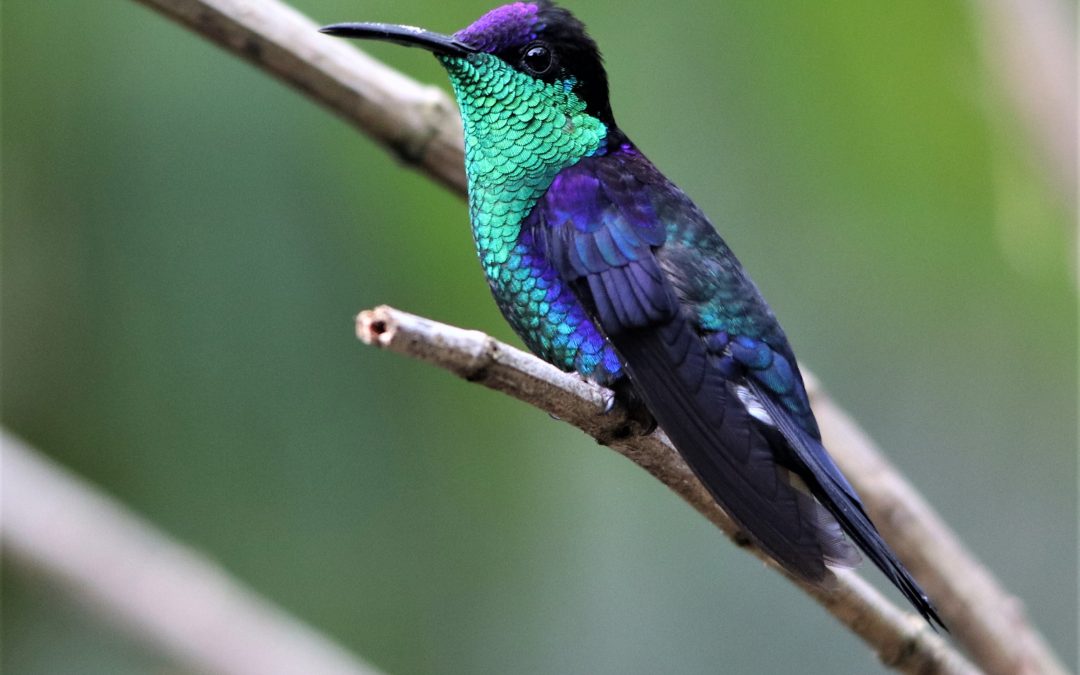
Hi Dominic,
Would like to have a chat with you sometime about Honduras. I spent a week there a few years ago with a small Naturetrek Group, based at Pico Bonito. Lancetilla and Cuero/Salado were also visited. Saw the Cotinga well several times and one day spotted a Roadrunner from the bus. Also enjoyed a night walk with one of the guides, incredible insects and reptiles.
Sadly I think many people live in fear of the police/military (and grinding poverty) and I doubt if I would ever go back notwithstanding the avian attractions. It is a world apart from the Costa Rica my wife and I visited independently about thirty years ago and which still seems a haven of relative stability in Central America. Glad you enjoyed the trip.
I was in the audience for your 2019 talk to a CHOG indoor meeting. And had great views of an otter on the afternoon of January 6th at Longham!